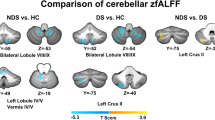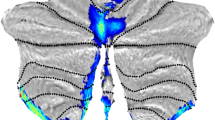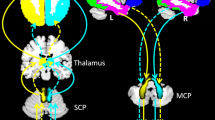Abstract
This study aimed to investigate the differences in cerebellar volumes and intrinsic cerebellar networks between patients with transient global amnesia (TGA) and healthy controls. We retrospectively enrolled patients with TGA and age- and sex-matched healthy controls. We used three-dimensional T1-weighted imaging at the time of TGA diagnosis to obtain cerebellar volumes, and the intrinsic cerebellar network was calculated by applying graph theory based on cerebellar volumes. The nodes were defined as individual cerebellar volumes, and edges as partial correlations, controlling for the effects of age and sex. The cerebellar volumes and intrinsic cerebellar networks were compared between the two groups. We enrolled 44 patients with TGA and 47 healthy controls. The volume of the left cerebellar white matter in patients with TGA was significantly lower than that in healthy controls (1.0328 vs. 1.0753%, p = 0.0094). In addition, there were significant differences in intrinsic cerebellar networks between the two groups. The small-worldness index in patients with TGA was higher than that in the healthy controls (0.951 vs. 0.880, p = 0.038). In the correlation analysis, the volumes of the right cerebellar cortex and lobules VIIIB were significantly correlated with age in patients with TGA (r = -0.323, p = 0.033; r = -0.313, p = 0.038, respectively). Patients with TGA exhibit alterations in cerebellar volumes and intrinsic cerebellar networks compared with healthy controls. These findings may contribute to a better understanding of the pathophysiology of the TGA.

Similar content being viewed by others
Data availability
Data that support the findings of this study are available from the corresponding author upon reasonable request.
Code availability
Not applicable.
References
Arena, J. E., Brown, R. D., Mandrekar, J., & Rabinstein, A. A. (2017). Long-term outcome in patients with transient global amnesia: a population-based study. Mayo Clinic Proceedings, 92(3), 399–405.
Arena, J. E., & Rabinstein, A. A. (2015). Transient global amnesia. Mayo Clinic Proceedings, 90(2), 264–272.
Ashida, R., Cerminara, N. L., Edwards, R. J., Apps, R., & Brooks, J. C. (2019). Sensorimotor, language, and working memory representation within the human cerebellum. Human Brain Mapping, 40(16), 4732–4747.
Bartsch, T., Alfke, K., Stingele, R., Rohr, A., Freitag-Wolf, S., Jansen, O., & Deuschl, G. (2006). Selective affection of hippocampal CA-1 neurons in patients with transient global amnesia without long-term sequelae. Brain, 129(11), 2874–2884.
Bartsch, T., & Deuschl, G. (2010). Transient global amnesia: Functional anatomy and clinical implications. The Lancet Neurology, 9(2), 205–214.
Billot, B., Magdamo, C., Arnold, S. E., Das, S., & Iglesias, J. E. (2022). Robust segmentation of brain mri in the wild with hierarchical cnns and no retraining. In International Conference on Medical Image Computing and Computer-Assisted Intervention (pp. 538–548).
Bocchetta, M., Cardoso, M. J., Cash, D. M., Ourselin, S., Warren, J. D., & Rohrer, J. D. (2016). Patterns of regional cerebellar atrophy in genetic frontotemporal dementia. NeuroImage: Clinical, 11, 287–290.
Brissenden, J. A., Tobyne, S. M., Halko, M. A., & Somers, D. C. (2021). Stimulus-specific visual working memory representations in human cerebellar lobule VIIb/VIIIa. Journal of Neuroscience, 41(5), 1033–1045.
Chen, S. A., & Desmond, J. E. (2005). Cerebrocerebellar networks during articulatory rehearsal and verbal working memory tasks. NeuroImage, 24(2), 332–338.
Desmond, J. E., Gabrieli, J. D., Wagner, A. D., Ginier, B. L., & Glover, G. H. (1997). Lobular patterns of cerebellar activation in verbal working-memory and finger-tapping tasks as revealed by functional MRI. Journal of Neuroscience, 17(24), 9675–9685.
Falsaperla, R., Vitaliti, G., Marino, S. D., Pratico, A. D., Mailo, J., Spatuzza, M., Cilio, M. R., Foti, R., & Ruggieri, M. (2021). Graph theory in paediatric epilepsy: A systematic review. Dialogues in Clinical Neuroscience, 23(1), 3–13. https://doi.org/10.1080/19585969.2022.2043128
Farahani, F. V., Karwowski, W., & Lighthall, N. R. (2019a). Application of Graph Theory for Identifying Connectivity Patterns in Human Brain Networks: A Systematic Review. Frontiers in Neuroscience, 13, 585. https://doi.org/10.3389/fnins.2019.00585
Farahani, F. V., Karwowski, W., & Lighthall, N. R. (2019). Application of graph theory for identifying connectivity patterns in human brain networks: A systematic review. frontiers in Neuroscience, 13, 585.
Foster, C. M., Kennedy, K. M., Hoagey, D. A., & Rodrigue, K. M. (2019). The role of hippocampal subfield volume and fornix microstructure in episodic memory across the lifespan. Hippocampus, 29(12), 1206–1223.
Gellersen, H. M., Guo, C. C., O’Callaghan, C., Tan, R. H., Sami, S., & Hornberger, M. (2017). Cerebellar atrophy in neurodegeneration—a meta-analysis. Journal of Neurology, Neurosurgery & Psychiatry, 88(9), 780–788.
Hallquist, M. N., & Hillary, F. G. (2019). Graph theory approaches to functional network organization in brain disorders: A critique for a brave new small-world. Netw Neurosci, 3(1), 1–26. https://doi.org/10.1162/netn_a_00054
Han, S., Carass, A., He, Y., & Prince, J. L. (2020). Automatic cerebellum anatomical parcellation using U-Net with locally constrained optimization. NeuroImage, 218, 116819. https://doi.org/10.1016/j.neuroimage.2020.116819
Hodel, J., Leclerc, X., Zuber, M., Gerber, S., Besson, P., Marcaud, V., Roubeau, V., Brasme, H., Ganzoui, I., & Ducreux, D. (2020). Structural connectivity and cortical thickness alterations in transient global amnesia. American Journal of Neuroradiology, 41(5), 798–803.
Hodges, J., & Warlow, C. (1990). Syndromes of transient amnesia: towards a classification. A study of 153 cases. Journal of Neurology, Neurosurgery & Psychiatry, 53(10), 834–843.
Jang, H., Lee, J. Y., Lee, K. I., & Park, K. M. (2017). Are there differences in brain morphology according to handedness? Brain and Behavior: A Cognitive Neuroscience Perspective, 7(7), e00730. https://doi.org/10.1002/brb3.730
Kang, J., Lee, D. A., Lee, H.-J., & Park, K. M. (2022). Limbic covariance network alterations in patients with transient global amnesia. Journal of Neurology, 269(11), 5954–5962.
Kim, B. S., Cho, S. S., Choi, J. Y., & Kim, Y. H. (2016). Transient global amnesia: A study with Tc-99m ECD SPECT shortly after symptom onset and after recovery. Diagnostic and Interventional Radiology, 22(5), 476.
Kim, J., Lee, D. A., Kim, H. C., Lee, H. J., & Park, K. M. (2021). Brain networks in patients with isolated or recurrent transient global amnesia. Acta Neurologica Scandinavica, 144(5), 465–472.
Larner, A. J. (2022). Transient global amnesia: model, mechanism, hypothesis. Cortex, 149, 137–147.
Lee, D. A., Lee, S., Kim, D. W., Lee, H.-J., & Park, K. M. (2021). Effective connectivity alteration according to recurrence in transient global amnesia. Neuroradiology, 63(9), 1441–1449.
Liang, K. J., & Carlson, E. S. (2020). Resistance, vulnerability and resilience: A review of the cognitive cerebellum in aging and neurodegenerative diseases. Neurobiology of Learning and Memory, 170, 106981.
Marvel, C. L., & Desmond, J. E. (2010). Functional topography of the cerebellum in verbal working memory. Neuropsychology Review, 20(3), 271–279.
Mijalkov, M., Kakaei, E., Pereira, J. B., Westman, E., Volpe, G., & Alzheimer's Disease Neuroimaging, I. (2017). BRAPH: A graph theory software for the analysis of brain connectivity. PLoS One, 12(8), e0178798. https://doi.org/10.1371/journal.pone.0178798
Morena, J., Kamdar, H. A., & Adeli, A. (2021). Cerebellar ischemia presenting as transient global amnesia. Cognitive and Behavioral Neurology, 34(4), 319–322.
Nakamoto, F. K., Tsutsumiuchi, M., Maeda, M. H., Uesaka, Y., & Takeda, K. (2015). Memory impairment following right cerebellar infarction: A case study. Neurocase, 21(5), 660–664.
Norris, D. (2017). Short-term memory and long-term memory are still different. Psychological Bulletin, 143(9), 992.
Pakkenberg, B., Pelvig, D., Marner, L., Bundgaard, M. J., Gundersen, H. J. G., Nyengaard, J. R., & Regeur, L. (2003). Aging and the human neocortex. Experimental Gerontology, 38(1–2), 95–99.
Park, K. M., Han, Y. H., Kim, T. H., Mun, C. W., Shin, K. J., Ha, S. Y., Park, J., & Kim, S. E. (2015). Pre-existing structural abnormalities of the limbic system in transient global amnesia. Journal of Clinical Neuroscience, 22(5), 843–847.
Park, K. M., Lee, B. I., & Kim, S. E. (2018). Is transient global amnesia a network disease? European Neurology, 80(5–6), 345–354.
Peer, M., Nitzan, M., Goldberg, I., Katz, J., Gomori, J. M., Ben-Hur, T., & Arzy, S. (2014). Reversible functional connectivity disturbances during transient global amnesia. Annals of Neurology, 75(5), 634–643.
Peterburs, J., Blevins, L. C., Sheu, Y.-S., & Desmond, J. E. (2019). Cerebellar contributions to sequence prediction in verbal working memory. Brain Structure and Function, 224(1), 485–499.
Peterburs, J., Liang, Y., Cheng, D. T., & Desmond, J. E. (2021). Sensory acquisition functions of the cerebellum in verbal working memory. Brain Structure and Function, 226(3), 833–844.
Schmahmann, J. D. (2019). The cerebellum and cognition. Neuroscience Letters, 688, 62–75.
Schmahmann, J. D., & Sherman, J. C. (1998). The cerebellar cognitive affective syndrome. Brain: a journal of neurology, 121(4), 561–579.
Spiegel, D. R., Smith, J., Wade, R. R., Cherukuru, N., Ursani, A., Dobruskina, Y., Crist, T., Busch, R. F., Dhanani, R. M., & Dreyer, N. (2017). Transient global amnesia: current perspectives. Neuropsychiatric Disease and Treatment, 2691–2703.
Stoodley, C. J. (2012). The cerebellum and cognition: Evidence from functional imaging studies. The Cerebellum, 11(2), 352–365.
Yang, Y., Kim, J. S., Kim, S., Kim, Y. K., Kwak, Y. T., & Han, I.-W. (2009). Cerebellar hypoperfusion during transient global amnesia: An MRI and oculographic study. Journal of Clinical Neurology, 5(2), 74–80.
Zidda, F., Griebe, M., Ebert, A., Ruttorf, M., Roßmanith, C., Gass, A., Andoh, J., Nees, F., & Szabo, K. (2019). Resting-state connectivity alterations during transient global amnesia. NeuroImage: Clinical, 23, 101869.
Acknowledgements
This work was supported by the Ministry of Science and ICT of the Republic of Korea (NRF-2021R1F1A1049605).
Funding
None.
Author information
Authors and Affiliations
Contributions
Author contributions included conception and study design (KMP), data collection or acquisition (DAL and HL), statistical analysis (KMP), interpretation of results (All authors), drafting the manuscript work or revising it critically for important intellectual content (All authors) and approval of final version to be published and agreement to be accountable for the integrity and accuracy of all aspects of the work (All authors).
Corresponding author
Ethics declarations
Competing interests
The authors declare no competing interests.
Declarations
This protocal was approved and carried out in accordance with the recommendation of the local Institutional Review Board (Haeundae Paik Hospital, Inje University College of Medicine, Busan, Korea).
Conflicts of interest
Neither of the authors has any conflict of interest to disclose.
Additional information
Publisher's Note
Springer Nature remains neutral with regard to jurisdictional claims in published maps and institutional affiliations.
Supplementary Information
Below is the link to the electronic supplementary material.
Rights and permissions
Springer Nature or its licensor (e.g. a society or other partner) holds exclusive rights to this article under a publishing agreement with the author(s) or other rightsholder(s); author self-archiving of the accepted manuscript version of this article is solely governed by the terms of such publishing agreement and applicable law.
About this article
Cite this article
Lee, D.A., Lee, HJ. & Park, K.M. Altered cerebellar volumes and intrinsic cerebellar networks in patients with transient global amnesia. Brain Imaging and Behavior (2023). https://doi.org/10.1007/s11682-023-00833-y
Accepted:
Published:
DOI: https://doi.org/10.1007/s11682-023-00833-y




